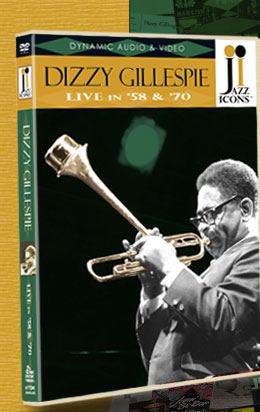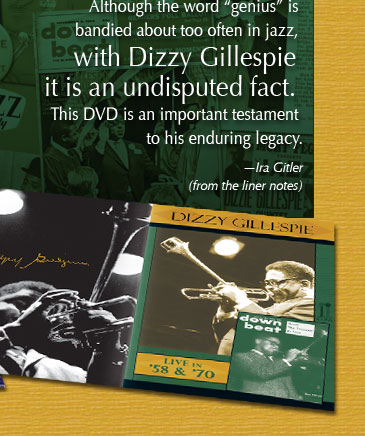




 |
 |
|
|||
|
|
|
||||
|
|
|
||||
|
|
|
||||
|
|
|
||||
 |
|
||||
 |
|
||||
 |
|
||||
|
|
|
|
|
|
|
 |
 |
 |
 |
Jazz Icons: Dizzy Gilespie features two historic concerts from one of the founding fathers of bebop. Filmed 12 years apart, the 1958 concert features Dizzy working eloquently within the small combo structure of a quintet including such influential musicians as sax player Sonny Stitt and bassist Ray Brown. The second show focuses on a completely different side of Dizzy, fronting the legendary Kenny Clarke-Francy Boland Big Band. With a 16-piece big band to conduct, including two drummers, his Latin influences are revealed on "Con Alma" and "Manteca." |
|
 |
|
Trumpet, Vocal- Dizzy Gillespie Tenor and Alto Sax, Vocal- Sonny Stitt Piano- Lou Levy Bass- Ray Brown Drums- Gus Johnson |
Blues After Dark On The Sunny Side Of The Street Loverman Cocktails For Two Blues Walk |
 |
|
|
Trumpet and Vocal- Dizzy Gillespie Alto Sax- Tony Coe and Derek Humble Tenor Sax- Billy Mitchell and Ronnie Scott Baritone Sax- Sahib Shihab Trumpet- Benny Bailey, Art Farmer, Dusko Goykovich and Idrees Sulieman Trombone- Nat Peck, Ake Persson, and Erik Van Lier Piano- Francy Boland Bass- Jimmy Woode Drums- Kenny Clare and Kenny Clarke |
Con Alma The Brother K Now Hear My Meanin’ Manteca Let Me Outta Here Things Are Here |
16-page booklet Liner notes by Ira Gitler Cover photo by Lee Tanner Booklet photos by Herman Leonard, Chuck Stewart, Raymond Ross, Karlheinz Klüter, Jamie Hodgson, Lee Tanner, Boo Frazier Memorabilia collage Total time: 85 minutes |
|
|
Sample Liner Notes by Ira Gitler: I started listening to jazz as a pre-teen in the Swing era, schooled by my older brother and surrounded by the sounds (through records and radio) and images (through movies and theater stage shows) of the big bands. I remember the buzz Benny Goodman’s band created with their appearance at the New York Paramount in March of 1937. It was the talk of our dinner table. I was 8 years old. By the end of 1938, at 10, my favorite was Count Basie, with Jimmie Lunceford a close second. Our record collection continued to grow and we had recordings from Harry James and Charlie Barnet to Erskine Hawkins and Edgar Hayes, as well as the very popular Cab Calloway. Two of those Calloway recordings, “Bye Bye Blues” and “A Bee Gezindt” had solos by Dizzy Gillespie, but I didn’t become aware of this until after I discovered him in 1945. As I was already heavily involved with jazz by this time, I can’t say that Dizzy Gillespie radically changed my life, but he strongly reinforced the direction I was going. Like many young musicians and fans of my generation, I embraced the music of Gillespie and Charlie Parker. I had already planned on a career as a writer, but this new passion brought it all into focus—I wanted to write about jazz. In 1946 my first jazz piece for my high school newspaper was centered on Gillespie’s appearance at the Spotlite Club on West 52nd Street. Dizzy had already announced himself to the jazz world at large in 1945 at the Three Deuces on that very same 52nd Street when he and alto saxophonist Charlie Parker led a quintet that changed the course not only of jazz, but music around the world. The recordings they made together in that time spread the message beyond the audiences of New York. .... Gillespie was not only an Olympian trumpeter, but was a personality who employed a variety of talents to edify and entertain his public. All of them had one thing in common—timing. “I’m a rhythm man, you know,” he once said. “I used to play for dancers.” Gillespie’s wife Lorraine was a dancer when he first met her. One night, when he was playing with the Teddy Hill Band at the Cotton Club, she was in the chorus line. “I loved to play for that chorus line,” he added. “One night I was playing something that made that line step, and Bill [“Bojangles”] Robinson was watching in the wings. He turned around to somebody and asked, ‘Where did that little bastard come from?’” Many young drummers who have come through his various bands have benefited from Gillespie’s tutelage. “I don’t know how to play the drums,” he said, “but I know how drums should sound.” .... “On The Sunny Side Of The Street” was a staple in Gillespie’s small band repertoire. It bounces lightly along with boppish rephrasing of the melody in places, and a call and response between the horns on the bridge. Dizzy is still utilizing his Harmon mute. Stitt has the first solo, doubling-up as was his wont and slipping in a sly, semi-quote of “My Sweetie Went Away.” Dizzy’s up next, also displaying the bopper’s penchant for quoting other songs, hinting at “Bewitched, Bothered And Bewildered” and “As Time Goes By.” In the vocal arrangement that Gillespie begins, with Stitt quickly joining in, liberties are taken with the lyric, reshaping both content and delivery. Stitt switches to alto for his ballad feature, “Loverman,” a song strongly associated with Billie Holiday but also, in a controversial light, with Charlie Parker. From the outset Stitt takes liberties with the melody. I remember attending a Stitt session for Prestige in the early ’50s. His manager was lecturing him about sticking close to the melody on a ballad so as not to baffle the public. (Saxophone ballads were big in jukeboxes at the time.) “Then, at the end,” cautioned the manager, “you can go for yourself.” Gillespie’s ballad is “Cocktails For Two,” a standard that I always associate with recordings by either Benny Carter or Spike Jones—from the sublime to the ridiculously funny. This version is a vignette, one chorus, but it demonstrates his piquant, singular harmonic sense. The quintet goes out blazing with “Blues Walk,” powered by the puissant pulse of Brown and time-master Johnson. Stitt, back on tenor, swings hard, fast and long. Levy cuts loose in a highly articulate flight, showing his Bud Powell roots. Catch the intricate, Dizzy-like figure that he spins at the very end of his solo. All words and artwork on this page ©Reelin' In The Years Productions. Unauthorized use is prohibited.
|
|
Site contents ©Copyright 2006 Reelin' In The Years Productions
Site designed by Tom Gulotta